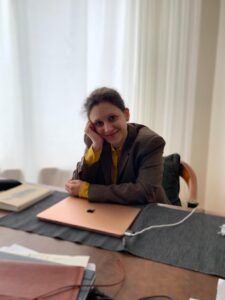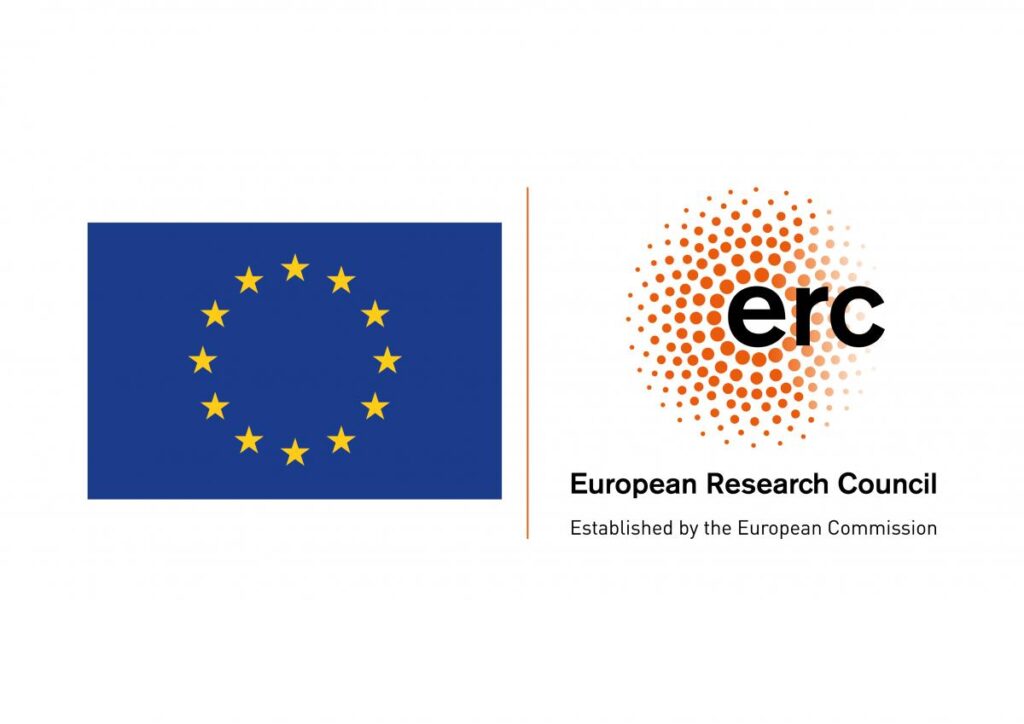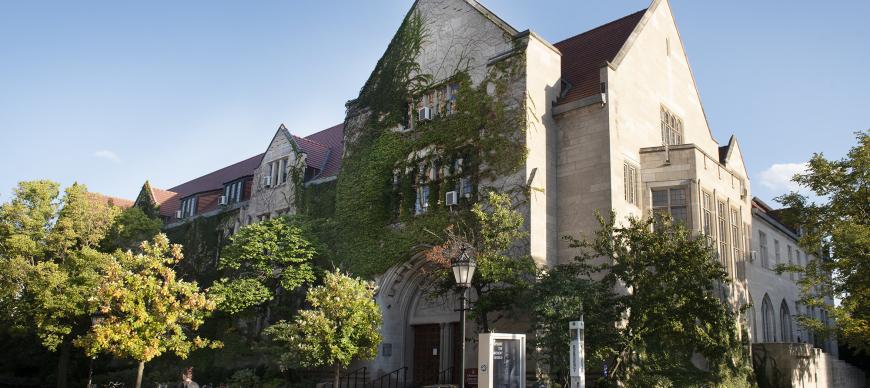This series of interviews shines a spotlight on researchers working on or with the Caliphal Finances project. Each interview showcases the variety of scholarship connected to our project’s research. This week, we feature Cecilia Palombo, a former guest of the project and Assistant Professor of Early Islamic History at the University of Chicago.
Could you briefly tell us about your background and career path?
When I was younger, I studied Classics and received training in late antique studies (thanks to a small but excellent BA program at the University of Rome La Sapienza which has since been discontinued). Curiosity for late antique things was part of my upbringing, because of growing up in and around Rome and of my mother’s work as a tourist guide in Rome (she was the first one to show me an archaeological site and the first one to took me on an ongoing dig). But I had never thought I would make it a profession. As a student I took classes in history, history of Christianity, art history, and archaeology. My interests were scattered but eventually shifted towards the end of late antiquity, or “Islamic late antiquity”. I also took a Master’s degree in archival studies in Rome, which I did not enjoy but that in time has proven to be quite a formative experience: I have never stopped thinking about how archives work and why they exist. Some fortuitous events and encounters shaped my career. Spending time in Syria and Jordan as a young person and the opportunity to enrol in an Islamic studies program at Oxford pushed me more towards Middle Eastern studies. I think that an instinctive love for Syria and the Bilad al-Sham played a role in shaping my choices when I was younger. I received a quite conventional “orientalist” education in terms of philology and approach to texts but interest in material culture and cities never left me and eventually came back with a revenge. Over the years I have also received a formal and semi-formal education in topics of cultural heritage studies (archival studies, Italian laws on cultural heritage, provenance research, and the illicit trade in antiquities). Now I spend at least part of the year in Turkey. For several years Istanbul has been my home, a city made of architectural and narrative layers which condenses all the “messiness” of late antiquity I enjoy, similarly to Rome, Antakya, Damascus, and other cities I care for. Chance more than a thought-out plan brought me to being a part of American academia, first as a graduate student and now as an assistant professor. In fact, at the beginning I was not at all attracted to academia; I thought working in publishing or for a museum or a cultural institution would be more fitting for me. I would say that places and people were the determinant factors in my career path. I was lucky to come across some fantastic and very influential teachers, including your project’s PI Marie Legendre, who introduced me to the Egyptian papyri, and my generous advisor Michael Cook. I did my PhD in Near Eastern studies at Princeton. Meanwhile, I spent a significant part of my PhD program in Leiden, where I collaborated with and later on worked in the ERC project “Embedding Conquest”, led by Petra Sijpesteijn. It was an incredibly formative experience, both personally and professionally.

Cecilia before an online conference during the pandemic. Image provided by Cecilia Palombo.
Can you summarise your main research areas and current projects?
My research areas are late antiquity, social histories of the early Islamic period (or, put differently, the study of early Islamicate societies), Islamicate documentary cultures, and issues of cultural heritage related to objects and sites from the late antique and medieval Middle East. I received training in papyrology and I often consult and do research with papyri from the early Islamic period; this has been a constant interest in my research since I was a Master’s student. But I have never self-identified as a papyrologist, in part for my lack of discipline when it comes to disciplinary norms. My research tends to focus on methodological questions, problems of historiography, and broad themes in social history (like literacy, multilingualism, everyday religious practice, or governance) more than on specific texts or kinds of texts. For example, I have recently published an article on the study of debt through documentary sources like multilingual papyri from Egypt. Documentary sources are often the protagonist in my work, but I have also published pieces on literary texts, like a recent study of the “History of the Patriarchs of Alexandria”, which deals largely with questions of method, about how to approach multilayered literary texts that grew and accrued meaning over time.
Currently I am working on a couple of projects. The most important one is a monograph on local communities in early Islamic administration. This is based on and expands beyond my PhD dissertation, which was a study of the interaction between monastic and government structures (people, chanceries, and libraries) in the administration of local communities in Umayyad and early Abbasid Egypt. At the center of the book is a concern with different and overlapping representations of “communities” that took shape at the local level, particularly from the perspective of local governance. I analyze these together with representations of “communities” that stem from the sources’ curation as part of collections of Middle Eastern artifacts, stressing that the sources are objects, with a focus on collections formed during the Mandates period and in the mid-twentieth century. The book interlaces narratives about the premodern and the modern Middle East. It still focuses on monastic and government milieus and the documents they created but discusses them by weaving together topics in Islamic history, archival studies, and cultural heritage preservation. Another project centers on the recent and contemporary illicit trade in antiquities from the Middle East and its complex relationship with the making of academic fields, particularly historical narratives and disciplinary methodologies. A third project concerns objects, narratives, and collections about early Islamic Constantinople (an oxymoron). At the University of Chicago, I work together with colleagues from various departments on topics in late antiquity and about the creation of cultural heritage as a concept and a practice.

Remains of spolia near the temple of Apollon Smintheion, Gülpınar, Turkey. Image provided by Cecilia Palombo.
How do fiscal theories, practices, and institutions feature in your work? How are you approaching these topics?
Fiscal theories, institutions, and practices are surprisingly quite prominent in my research. I think this is because of their prominence in the extant sources, both documentary and literary, and in narratives of good governance. I do not have a specific interest in fiscal matters (and I am famously bad at math), but they pop up forcibly when dealing with all sorts of disparate matters. Years ago, I was interested in a group of Christian homilies composed and transmitted in Egypt in monastic circles in the Abbasid period, because I had the intuition that the authors referred ambiguously to some issues of daily governance by concealing them behind traditional religious themes; and even in that case, as I was reading religious texts, I soon realized that to understand what issues the authors were subtly concerned with I needed to study the fiscal documentation that is associated with findings from monastic sites. I have spent quite a lot of time studying fiscal receipts, because these can tell us about much more than taxation, as your research team knows very well. For example, they tell us about literacy, scribal cultures, and social interactions at the local level, debts, imprisonment, poverty, the presence of women in business, not to mention other topics like agricultural practices or the availability and price of food products.
In your opinion, what is a key argument or prevailing assumption in Islamic fiscal history that needs to be challenged?
One concern in the study of fiscal history is the tendency to separate fiscal institutions in Islamic literature (like legal, historical, and didactic texts) from the fiscal reality that one can glimpse based on documentary sources, particularly documents written in Greek, or Coptic, or not in Arabic. I am interested in the complex relationship between fiscal theories and discourses and fiscal practices. The two always diverge in significant ways and sometimes seem to really go in opposite directions, which is interesting in and by itself. I explore some of these contradictions in my book. Prescriptive theories and recorded practices do not inhabit the same kinds of texts. For this reason, it is easier to separate their study (and I know that your project is going a long way towards addressing and redressing this separation). However, unlike other scholars, I am convinced that Islamic legal discourses permeated fiscal practice on the ground since the very early Islamic period. In the literature there is often the sense that for quite a long time Islamic institutions were absent, poorly visible, or scarcely developed. And yet, everyone who studies the early Islamic period also inevitably talks about fiscal matters. And so there would be a fiscal history that is already part of Islamic history since the early conquests but that, paradoxically, is placed outside or before the development of “properly Islamic” institutions, to put it simply. I think this is incorrect. The perceived absence of Muslims and of Islamic institutions derives from a tendency in part of the scholarship not to engage with Islamic texts. It is a methodological pitfall. I am convinced that fiscal practices were varied, complicated, and adaptable to many different circumstances, but they never existed in an institutional vacuum.

Cecilia teaching Umayyad history inside the TiEM Museum, Istanbul, Turkey. Image provided by Cecilia Palombo.
A big thank you to Cecilia Palombo for sharing her thoughts with us this week! To read more of these interviews with friends of the Caliphal Finances project, click here.
Banner image: The Institute for the Study of Ancient Cultures of Chicago, where the ISAC papyri collection and Cecilia’s office are found. Credit: ISAC.




Leave a Reply